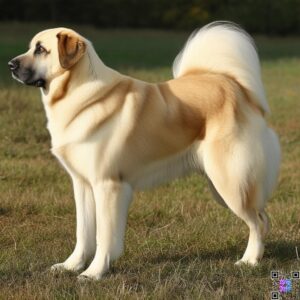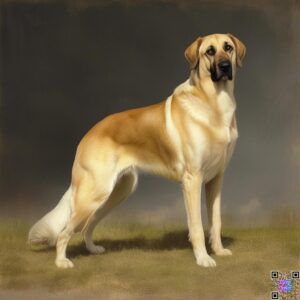Introduction
The Anatolian Shepherd is a majestic breed known for its impressive size, strength, and loyalty. While their muscular build and protective nature often steal the spotlight, the Anatolian Shepherd’s tail is a fascinating feature that deserves attention. In this comprehensive guide, we’ll explore the anatomy, structure, and significance of the Anatolian Shepherd Tail, as well as delve into the controversies surrounding tail docking and the various types of tails found in this breed.
Anatomy and Structure of the Anatolian Shepherd Tail

The Anatolian Shepherd Tail is composed of a series of vertebrae and muscles that allow for a wide range of motion and expression. The size and shape of the tail can vary among individual dogs, with some having a more pronounced curve or sickle shape, while others may have a straighter tail. The tail carriage and movement are also important indicators of the dog’s mood and temperament.
Tail Docking in Anatolian Shepherds
Tail docking is the practice of removing a portion of the tail, often performed on newborn puppies. While the purpose of tail docking is to prevent potential injuries and infections, it remains a controversial topic. Many countries have banned or restricted the practice, and some argue that it is unnecessary and inhumane. It’s important to research the legal status and regulations surrounding tail docking in your area before making a decision.
Anatolian Shepherd Tail Types
There are several types of Anatolian Shepherd tails, each with its own unique characteristics:
Curled Tail
A curled tail is one that curves over the back, often resembling a sickle shape. This type of tail is common in Anatolian Shepherds and is considered a desirable trait by some breed standards.
Sickle Tail
A sickle tail is similar to a curled tail, but it has a more pronounced curve that extends further over the back. This type of tail is also common in Anatolian Shepherds.
Straight Tail
A straight tail is one that extends straight back from the body, with little to no curve. While less common in Anatolian Shepherds, straight tails are still seen in some individuals.
Kinked Tail
A kinked tail is one that has a sharp bend or kink in it, often caused by an injury or genetic abnormality. Kinked tails are relatively rare in Anatolian Shepherds and may be considered a fault by some breed standards.
Tail Injuries and Health Issues
Anatolian Shepherd tails are susceptible to various injuries and health issues, such as:
- Tail injuries caused by accidents or rough play
- Tail infections, particularly in docked tails
- Tail amputation due to severe injuries or infections
- Neurological issues affecting tail movement and sensation
It’s important to monitor your Anatolian Shepherd’s tail for any signs of injury or infection and to seek veterinary attention if any issues arise.
Grooming and Maintenance of the Anatolian Shepherd Tail
Proper grooming and maintenance are essential for keeping your Anatolian Shepherd’s tail healthy and free from tangles and matting. Regular brushing and trimming can help keep the fur in good condition, while cleaning and disinfecting can prevent infections and odors.
Anatolian Shepherd Tail Language
The Anatolian Shepherd’s tail is a powerful tool for communication, with various positions and movements conveying different meanings:
- Tail wagging can indicate happiness, excitement, or greeting
- Tail tucking can signify fear, submission, or discomfort
- The position of the tail can reflect the dog’s mood, with a high, relaxed tail indicating confidence and a low, tucked tail indicating stress or anxiety
Understanding the language of the Anatolian Shepherd Tail can help owners better interpret their dog’s emotions and needs.
Tail Structure and Function
Anatolian Shepherds possess a bushy tail that curls over their back when they are relaxed or alert. This tail structure is not merely aesthetic; it serves practical purposes as well. When guarding livestock, the tail acts as a visual signal to sheep or goats. A raised tail indicates alertness or potential danger, prompting the flock to seek shelter or position themselves behind the dog.
Tail Communication with Livestock
In addition to its signaling function, the tail serves as a tool for communication between the dog and its flock. The way an Anatolian Shepherd moves its tail can indicate its emotional state—whether it’s calm, excited, or agitated. Understanding these signals is crucial for handlers who work closely with these dogs in agricultural settings.
Tail Movements and Their Meanings
Different tail movements can signify various emotions or intentions. For instance:
- A high-held tail may indicate confidence or alertness.
- A low-hanging tail might suggest submission or relaxation.
- Rapid wagging could express excitement or eagerness.
Recognizing these cues can enhance the bond between the handler and their dog while ensuring effective livestock management.

Frequently Asked Questions
1- What is the purpose of the Anatolian Shepherd’s tail?
The Anatolian Shepherd’s tail serves several purposes, including balance, communication, and temperature regulation.
2- Is tail docking necessary for Anatolian Shepherds?
Tail docking is a controversial practice, and its necessity is debated. Some argue it prevents injuries and infections, while others consider it unnecessary and inhumane.
3- How can I keep my Anatolian Shepherd’s tail healthy?
Regular grooming, including brushing, trimming, and cleaning, can help keep your Anatolian Shepherd’s tail healthy. Monitor for any signs of injury or infection and seek veterinary attention if needed.
4- What does it mean when an Anatolian Shepherd wags its tail?
Tail wagging in Anatolian Shepherds can indicate happiness, excitement, or greeting. The speed and position of the wag can convey different meanings.
5- Can an Anatolian Shepherd’s tail be docked for cosmetic reasons?
In many countries, tail docking for cosmetic reasons is illegal or highly restricted. It’s important to research the laws and regulations in your area before considering tail docking.
6- How do I groom my Anatolian Shepherd’s tail?
Brush your Anatolian Shepherd’s tail regularly to remove tangles and mats. Trim the fur as needed to maintain a neat appearance. Clean and disinfect the tail to prevent infections and odors.
Conclusion
The Anatolian Shepherd Tail is a fascinating feature that deserves attention and appreciation. From its anatomy and structure to its role in communication and health, the Anatolian Shepherd Tail is an integral part of this loyal and majestic breed. By understanding the importance of the tail and properly caring for it, Anatolian Shepherd owners can ensure their dogs’ well-being and happiness.
